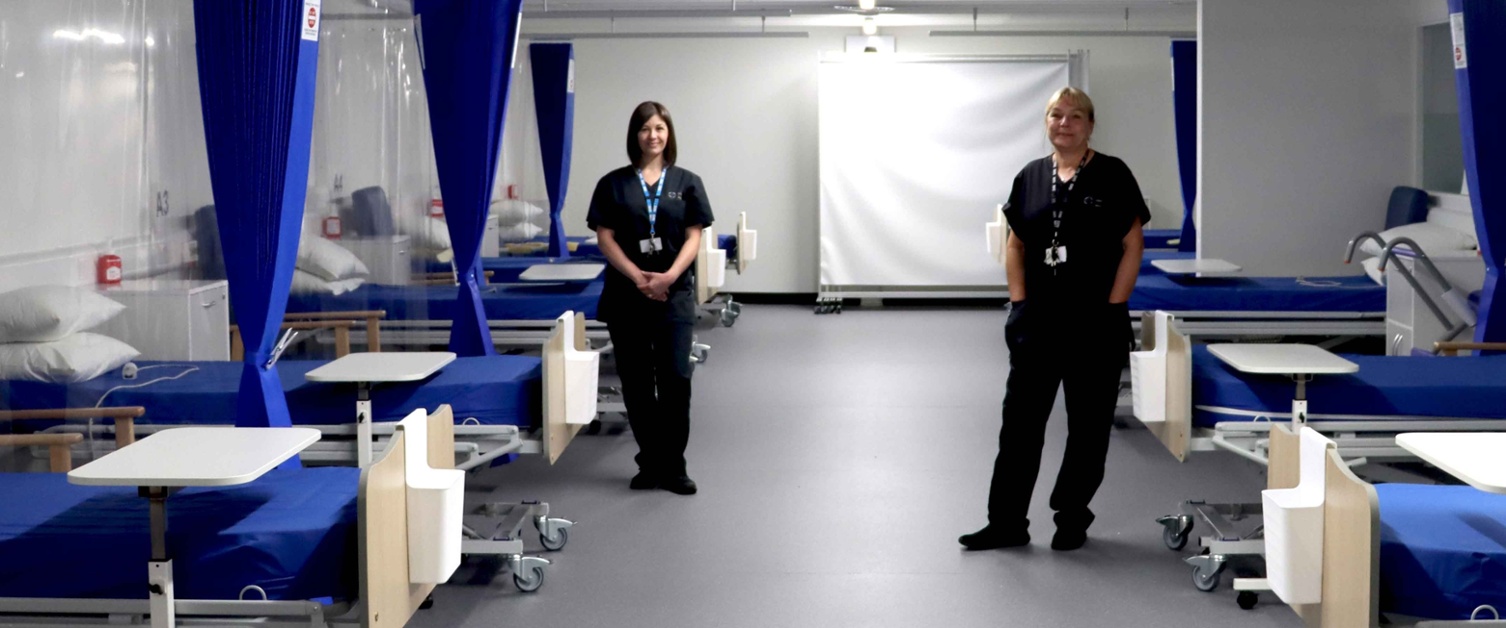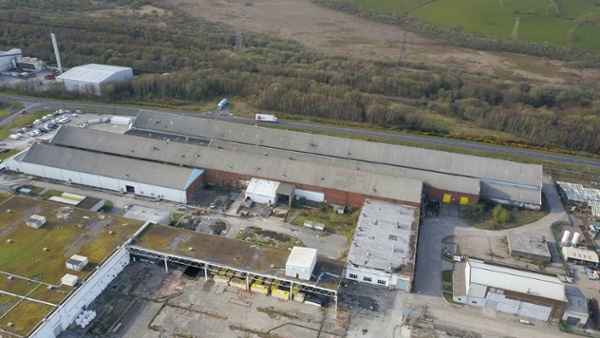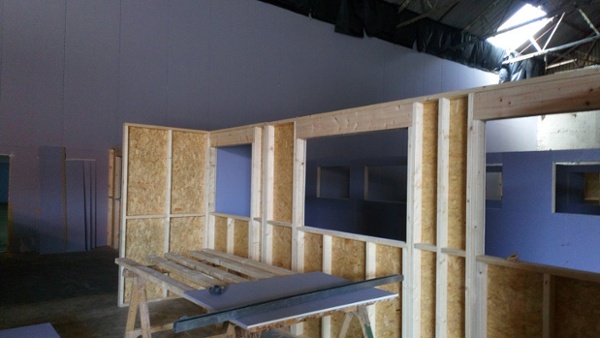Bye bye to the Bay Field Hospital

Main image: Bay Field Hospital Site Manager Kelly John, left, and Project Lead Sally Bloomfield on Pennard Ward, one of the last field hospital wards to be decommissioned.
A field hospital built from scratch at lightning speed to care for Covid patients but which ended up vaccinating hundreds of thousands is closing its doors after two years.
Although it was never used for its original purpose, the Bay Field Hospital has become a mainstay of health services in Swansea Bay during the pandemic.
As well as vaccinations, it has provided a venue for antibody testing, blood tests, nurse training and an outpatients’ service for people with Long Covid.
With decommissioning work due to begin at the end of July, the beds are being found new homes, equipment is being shared out between hospitals and community services and all services are being relocated.
Blood tests will be the last service to leave the building later this month. The last day blood testing will be done at the Bay Field Hospital is Friday, July 22nd.
A new community blood test hub is opening at the Port Talbot Resource Centre in Baglan in early August.
It will be in addition to the current outpatient blood test clinics at Morriston, Singleton and Neath Port Talbot hospitals, which will also increase the number of appointments they offer when the Bay blood test clinic closes.
The cavernous former Elba building on the Bay Studios site just outside Swansea, in which rear axles for Ford cars and vans were once made, was identified for transformation into one of two field hospitals for the area in spring 2020.
 The cavernous former Elba building on the Bay Studios site just outside Swansea.
Credit: Swansea Council
The cavernous former Elba building on the Bay Studios site just outside Swansea.
Credit: Swansea Council
 The interior of the Elba building before work began on the field hospital.
Credit: Swansea Council
The interior of the Elba building before work began on the field hospital.
Credit: Swansea Council
Bay Studios landlord Roy Thomas handed the building over to the health board rent free for the first 16 months.
The other field hospital was created a few miles away at Llandarcy Sports Academy.
Sally Bloomfield was seconded from her usual and very different role in the health board to lead the Bay project.
She said: “As an Allied Health Professional (clinicians who are not doctors or nurses) I thrive on problem solving and being given a challenge. In the beginning I was also quite scared because it was really out of my comfort zone and nothing I ever expected to be asked to do in my career.”
Swansea Council’s building services team stepped in to oversee a high-speed construction process, using their own expertise and bringing together hundreds of contractors. It was delivered on time and on budget.
Council leader Rob Stewart said: “Our teams worked expertly with a broad range of partners. Their expertise and dedication was a key factor in the success of this remarkable construction project. We were delighted to help in this way – and many others - as our communities faced the worry and major challenges of the pandemic.”
At the time hospitals in Italy and Spain were being overwhelmed by large numbers of seriously ill Covid patients and scientific modelling suggested the tidal wave of infection would hit the UK’s shores within weeks.
The NHS had to make extra beds available, with modelling at the time indicating that more than 1,000 may be needed in the Swansea Bay area.
Outpatient departments and operating theatres in existing hospitals were transformed into makeshift intensive care units and wards, but there still wasn’t enough space for all the beds the modelling suggested would be required.
So the health board’s primary, community and therapy services (PCTS) group was tasked with creating the field hospitals alongside the local councils, the military and private contractors in an unprecedented £18m project.
Sally, who was seconded from her substantive role as a senior PCTS manager, Mark Jarrett from the health board’s capital planning department and their partners discovered that while the Elba building was big enough at 11,000 square metres, it had holes in the roof and there was no access to the mains sewer network, or an electricity and water supply.
It was a unique venue for a field hospital as others in the UK were created within stadiums, sports halls or similar venues which had better existing infrastructure.
“We would say it was from “handbags and glad rags” to hard hats and steel toe-capped boots,” said Sally.
“It was exciting, scary and a huge privilege. An absolutely fascinating process. We just had to do what we had to do – decisions had to be taken then and there.
“Everyone just came together and somehow, between us all, we achieved what was needed.
“There was a common goal, a common objective and everybody knew what that was, from the labourers and contractors to the health board staff who helped out.
“It was a mammoth task and collaboration at its very best.
“Roy Thomas was brilliant, handing over the building for us to use with no hesitation.”
Working with contractors Kier and TRJ, Swansea Council came up with the innovative solution of building a box within the Elba building to house the hospital.
Four hundred contractors were drafted onto site, often working around the clock.
The box was constructed using thousands of boards which were screwed together and sealed with silicone sealant which, if squeezed out in one line, would measure the same height as Mount Everest three times over.
 The wards begin to take shape in spring 2020.
Credit: Swansea Council
The wards begin to take shape in spring 2020.
Credit: Swansea Council
Twelve football pitches could have been covered with the insulation sheets used and more than 700km of cabling was used – enough to stretch from Swansea to Edinburgh.
In just 31 days between April 6th, 2020, and May 7th, 2020, the Bay Field Hospital was constructed containing five wards with 420 beds.
All wards were named after Welsh castles to symbolise protection of the public served by the health board.
Unlike the Nightingale hospitals in England, the Bay was not designed to be an intensive care unit.
The intention was to free up space in hospitals by transferring Covid and non-Covid patients who were out of danger to Llandarcy at first and then, as they recovered further, to the Bay before returning home.
Patients would have been brought to the BFH by ambulance, entering through the door which is currently the access to the blood test service.
However, one of the issues of the box-within-a-building design was that the wards had minimal access to natural light or to the outside meaning patients wouldn’t have had any idea whether it was light or dark or if it was raining or sunny.
So staff put white boards up in the wards with stickers which staff could change to tell patients what day of the week it was and what the weather was like.
A further seven wards with beds were added by the end of June 2020 and those from Llandarcy were transferred there when it closed in October 2020.
Until recently Sally and her team, which included site managers Kelly John and Kate Ashton, were required to keep 330 beds on standby for activation at 72 hours’ notice.
Thankfully, at no time during the pandemic were the field hospital beds at Llandarcy or BFH required as the extra capacity provided in Morriston, Singleton and Neath Port Talbot hospitals was sufficient.
Now 350 of the BFH beds, which are not suitable for use in the health board’s main hospitals, have been donated to good causes including a refugee camp in Moldova for people fleeing the war in Ukraine, families who are hosting Ukrainian refugees and local families in bed poverty.
The rest will be repurposed or donated as necessary.
But Sally said: “Had we not built the field hospital and needed it, that would have been a travesty. It would have been catastrophic.
“At the time, when we were really living in the epicentre of all the modelling and planning, it was very real that these places were going to be needed.
“People were dying. There was no vaccine on the horizon.
“But while we haven’t used it as a field hospital. It has been used for lots of other things.”
By December 2020 the BFH had become the home of a new Mass Vaccination Centre as the first Pfizer vaccine was rolled out to health and social care staff.
It was the biggest of the additional services to be provided at the Bay.
In what was to become the NHS’ largest-ever vaccination campaign, more than 400,000 people aged five and up received first, second and booster doses there over the last 18 months.
Vaccinations have also been given at the now closed Margam Orangery MVC, Canolfan Gorseinon Centre, which is still operating, GP surgeries, in pharmacies, care homes, on the Immbulance mobile vaccination clinic and in various community venues across the region.
Like the field hospital, the creation of the Bay MVC was unprecedented and swift.
But it is the staff who have manned it with total commitment which have made the real difference.
As with the field hospital they were drafted in from their normal roles across the health board. Others came out of retirement, while some were recruited.
More than 12,000 people were being invited there for vaccination every week at its busiest time in December 2021.
“Everyone has been like a family here through such a tough time. We have stuck it out,” said patient flow coordinator Gemma Thomas.
“It’s been something we will look back on as an incredible achievement,” said Rebecca Maus, a clinical lead in the vaccination programme.
“At the busiest times people were giving up their days off and staying late to make sure people were vaccinated.
“The enthusiasm from staff has been incredible.”
Clinical supervisor Judith Jenkins worked at the Bay MVC from day one.
“It was very challenging in the beginning, but I think it’s superb the way it all came together with everybody from across different disciplines working as one.
“We have had retired consultants to anybody and everybody and it’s been a pleasure working with so many different skill sets.”
Retired dental surgeon Paul John returned to the frontline at the MVC on day two of its operation.
He said: “I heeded the call (for retired NHS staff to return) and have worked full time ever since.”
Along with his colleagues, he has also vaccinated on the Immbulance and out in the community throughout the pandemic.
But it will be the early days of public vaccination at the Bay MVC, which was the first opportunity many older people had to leave their homes, which will stay with him.
“Last year there were two 80 year olds who were sat next to each other. They got talking and the man found out that the woman next to him had been his first girlfriend when they were in school,” he recalled.
Retired pathologist Adrian Yoong also volunteered his services.
“We wanted to do something to help out,” he said.
“It’s been a great coordination of people from mixed professional backgrounds and it’s worked pretty well.”
Sam Seppings, 19, has been a more recent addition to the team as a non-registrant vaccinator, those who are not doctors, nurses or other clinical professionals.
It’s been the ideal training ground for the aspiring doctor, who is transferring with colleagues to the new Local Vaccination Centre at the Aberafan Shopping Centre in Port Talbot before heading off to medical school in September.
“It’s given me a lot of experience and it’s been great working with nurses who have been able to point me in the right direction,” he said.
But vaccinator was just one of the job roles at the centre.
Health board volunteers, reception and booking centre staff all played their vital part in getting huge numbers of people booked in for vaccination, through the doors and out again as efficiently as possible.
Patient flow coordinator Gemma Thomas helped get the most vulnerable patients through the centre quicker and with less stress.
“There were times when we had long queues, so we would identify those with additional needs and try to make sure the experience was easier for them,” she said.
“It could be as simple as providing a bottle of water, a seat or getting someone a wheelchair or even getting them out of the queue and into a quieter area.”
Harry Wills-Jones, 16, was among the last people to be vaccinated at the Bay.
His dad Wayne, who has also been vaccinated at the Bay, said: “I’ve been here at some of the busiest times and it’s good that we’re getting back to normality.
“I respect what you guys have been through.”
Rydym yn croesawu gohebiaeth a galwadau ffôn yn y Gymraeg neu'r Saesneg. Atebir gohebiaeth Gymraeg yn y Gymraeg, ac ni fydd hyn yn arwain at oedi. Mae’r dudalen hon ar gael yn Gymraeg drwy bwyso’r botwm ar y dde ar frig y dudalen.
We welcome correspondence and telephone calls in Welsh or English. Welsh language correspondence will be replied to in Welsh, and this will not lead to a delay. This page is available in Welsh by clicking ‘Cymraeg’ at the top right of this page.